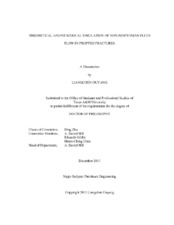| dc.description.abstract | The flow of non-Newtonian fluids in porous media is important in many applications, such as polymer processing, heavy oil flow, and gel cleanup in propped fractures. Residual polymer gel in propped fractures results in low fracture conductivity and short effective fracture length, sometimes causing severe productivity impairment of a hydraulically fractured well. Some residual gels are concentrated in the filter cakes built on the fracture walls and have much higher polymer concentration than the original gel. The residual gel exhibits a higher yield stress, and is difficult to remove after fracture closure. But non-Newtonian fluid has complicated rheological equation and its flow behavior in porous media is difficult to be described and modeled. The Kozeny-Carman equation, a traditional permeability-porosity relationship, has been popularly used in porous media flow models. However, this relationship is not suitable for non-Newtonian fluid flow in porous media.
At first, I studied polymer gel behavior in hydraulic fracturing theoretically and experimentally. I developed a model to describe the flow behavior of residual polymer gel being displaced by gas in parallel plates. I developed analytical models for gas-liquid two-phase stratified flow of Newtonian gas and non-Newtonian residual gel to investigate gel cleanup under different conditions. The concentrated gel in the filter cake was modeled as a Herschel-Buckley fluid, a shear-thinning fluid following a power law relationship, but also having a yield stress.
Secondly, I used a combination of analytical calculations and 3D finite volume simulation to investigate the flow behavior of Herschel-Bulkley non-Newtonian fluid flow through propped fractures. I developed the comprehensive mathematical model, and then modified the model based on numerical simulation results. In the simulations, I developed a micro pore-scale model to mimic the real porous structure of flow channel in propped fractures. The correlation of pressure gradient and superficial velocity was investigated under the influence of primary parameters, such as yield stress, power law index, and consistency index. I also considered the effect of proppant packing arrangement and proppant diameter. The Herschel-Bulkley model was used with an appropriate modification proposed by Papanastasiou to avoid the discontinuity of the apparent viscosity and numerical difficulties. | en |


